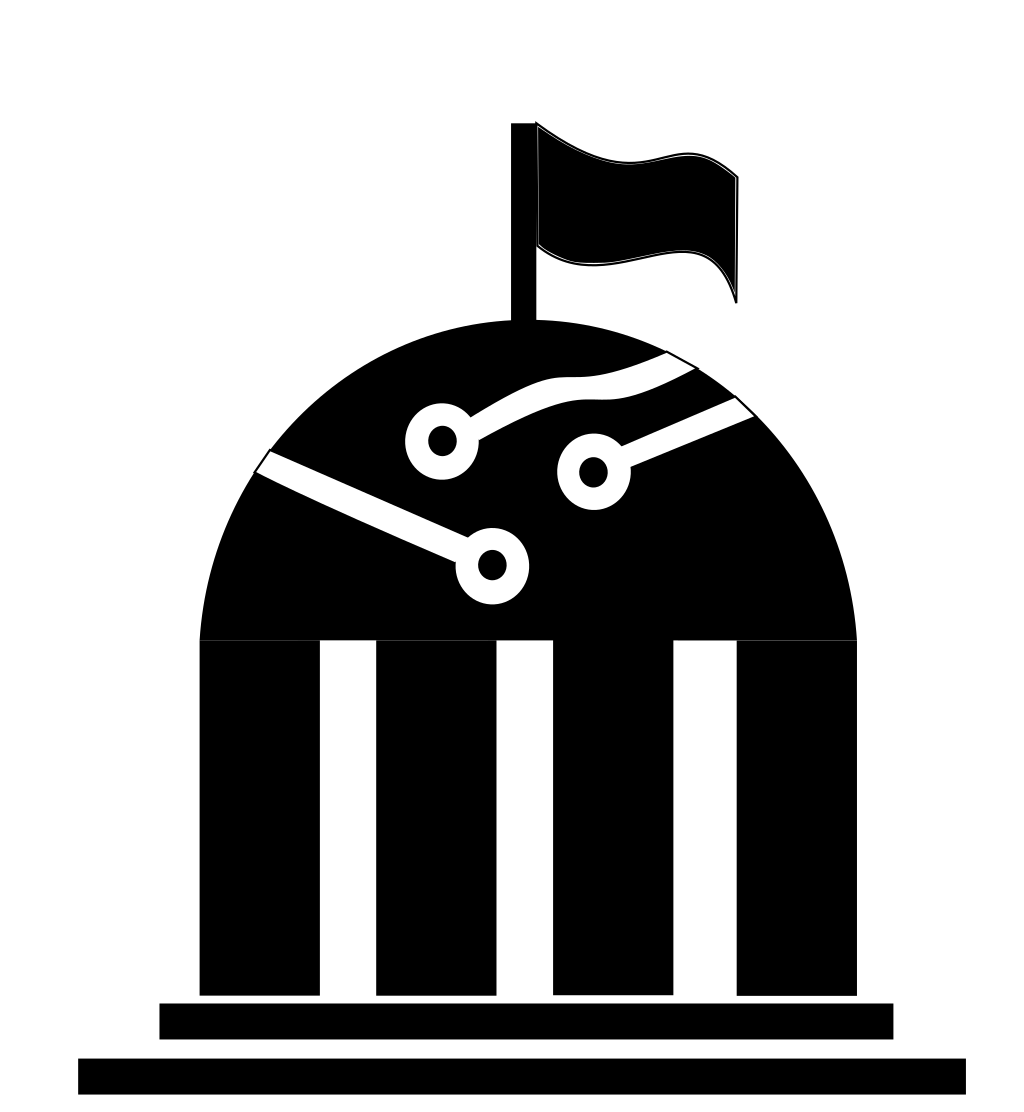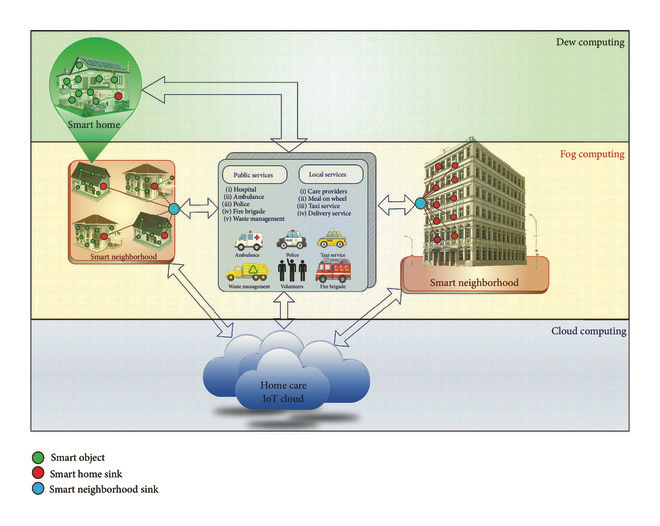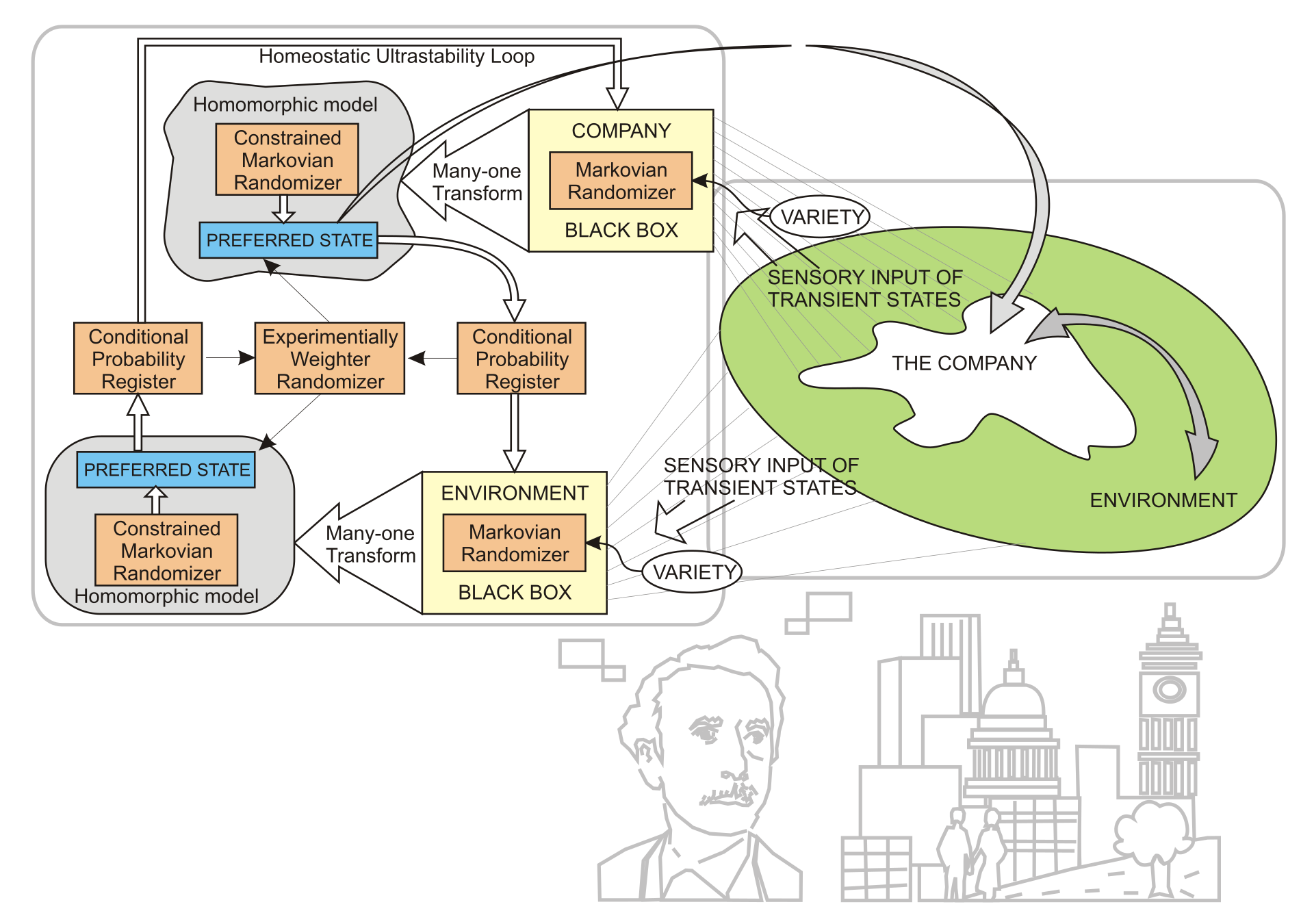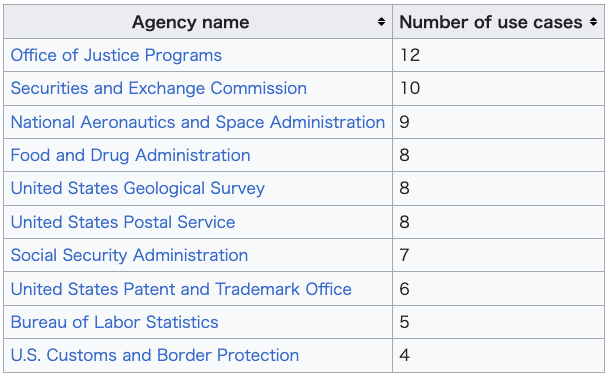
アルゴリズムによる統治
Government by algorithm
☆
アルゴリズムによる統治[1][Government by
algorithm](アルゴリズム規制[2]、アルゴリズムによる規制、アルゴリズムガバナンス[3][4]、アルゴクラティックガバナンス、
アルゴリズム的法秩序、アルゴクラシー[5]とも呼ばれる)は、規制、法執行、および交通や土地登記などの日常生活のあらゆる側面に対してコンピュータア
ルゴリズムを適用する、代替的な形態の政府または社会秩序である[6][7][8][9]。[10]
「アルゴリズムによる政府」という用語は、2013年に「アルゴリズムによる統治」の代替用語として学術文献に登場した。[11]
関連用語である「アルゴリズム規制」は、計算アルゴリズムを用いて基準を設定し、行動を監視・修正するものと定義され、司法の自動化もその範囲に含まれ
る。[12]
アルゴリズムによる政府は、電子政府に関する文献や行政の実務では捉えられていない新たな課題を引き起こしてる。[13]
一部の情報源は、情報の有効活用によって統治される仮想的な政府形態であるサイバークラシー[14][15][16]
を、アルゴリズムによるガバナンスと同一視してるが、アルゴリズムは情報を処理する唯一の手段ではない。[17][18]
ネロ・クリスティアーニとテレサ・スキャンタンブルロは、人間社会と特定の規制アルゴリズム(評判に基づくスコアリングなど)の組み合わせが「社会的機
械」を形成すると主張している。[19]
| Government by
algorithm[1] (also known as algorithmic regulation,[2] regulation by
algorithms, algorithmic governance,[3][4] algocratic governance,
algorithmic legal order or algocracy[5]) is an alternative form of
government or social ordering where the usage of computer algorithms is
applied to regulations, law enforcement, and generally any aspect of
everyday life such as transportation or land
registration.[6][7][8][9][10] The term "government by algorithm" has
appeared in academic literature as an alternative for "algorithmic
governance" in 2013.[11] A related term, algorithmic regulation, is
defined as setting the standard, monitoring and modifying behaviour by
means of computational algorithms – automation of judiciary is in its
scope.[12] Government by algorithm raises new challenges that are not captured in the e-government literature and the practice of public administration.[13] Some sources equate cyberocracy, which is a hypothetical form of government that rules by the effective use of information,[14][15][16] with algorithmic governance, although algorithms are not the only means of processing information.[17][18] Nello Cristianini and Teresa Scantamburlo argued that the combination of a human society and certain regulation algorithms (such as reputation-based scoring) forms a social machine.[19] |
アルゴリズムによる統治[1](アルゴリズム規制[2]、アルゴリズム
による規制、アルゴリズムガバナンス[3][4]、アルゴクラティックガバナンス、アルゴリズム的法秩序、アルゴクラシー[5]とも呼ばれる)は、規制、
法執行、および交通や土地登記などの日常生活のあらゆる側面に対してコンピュータアルゴリズムを適用する、代替的な形態の政府または社会秩序である[6]
[7][8][9]。[10]
「アルゴリズムによる政府」という用語は、2013年に「アルゴリズムによる統治」の代替用語として学術文献に登場した。[11]
関連用語である「アルゴリズム規制」は、計算アルゴリズムを用いて基準を設定し、行動を監視・修正するものと定義され、司法の自動化もその範囲に含まれ
る。[12] アルゴリズムによる政府は、電子政府に関する文献や行政の実務では捉えられていない新たな課題を引き起こしてる。[13] 一部の情報源は、情報の有効活用によって統治される仮想的な政府形態であるサイバークラシー[14][15][16] を、アルゴリズムによるガバナンスと同一視してるが、アルゴリズムは情報を処理する唯一の手段ではない。[17][18] ネロ・クリスティアーニとテレサ・スキャンタンブルロは、人間社会と特定の規制アルゴリズム(評判に基づくスコアリングなど)の組み合わせが「社会的機 械」を形成すると主張している。[19] |
History Computer-generated image of Project Cybersyn operations room  LEGOL Group (1977)  "Blockchain and the future of governance. Let's overcome the hype and understand what can be done." with Andrea Bauer, Boris Moshkovits und Shermin Voshmgir at re:publica In 1962, the director of the Institute for Information Transmission Problems of the Russian Academy of Sciences in Moscow (later Kharkevich Institute),[20] Alexander Kharkevich, published an article in the journal "Communist" about a computer network for processing information and control of the economy.[21][22] In fact, he proposed to make a network like the modern Internet for the needs of algorithmic governance (Project OGAS). This created a serious concern among CIA analysts.[23] In particular, Arthur M. Schlesinger Jr. warned that "by 1970 the USSR may have a radically new production technology, involving total enterprises or complexes of industries, managed by closed-loop, feedback control employing self-teaching computers".[23] Between 1971 and 1973, the Chilean government carried out Project Cybersyn during the presidency of Salvador Allende. This project was aimed at constructing a distributed decision support system to improve the management of the national economy.[24][2] Elements of the project were used in 1972 to successfully overcome the traffic collapse caused by a CIA-sponsored strike of forty thousand truck drivers.[25] Also in the 1960s and 1970s, Herbert A. Simon championed expert systems as tools for rationalization and evaluation of administrative behavior.[26] The automation of rule-based processes was an ambition of tax agencies over many decades resulting in varying success.[27] Early work from this period includes Thorne McCarty's influential TAXMAN project[28] in the US and Ronald Stamper's LEGOL project[29] in the UK. In 1993, the computer scientist Paul Cockshott from the University of Glasgow and the economist Allin Cottrell from the Wake Forest University published the book Towards a New Socialism, where they claim to demonstrate the possibility of a democratically planned economy built on modern computer technology.[30] The Honourable Justice Michael Kirby published a paper in 1998, where he expressed optimism that the then-available computer technologies such as legal expert system could evolve to computer systems, which will strongly affect the practice of courts.[31] In 2006, attorney Lawrence Lessig, known for the slogan "Code is law", wrote: [T]he invisible hand of cyberspace is building an architecture that is quite the opposite of its architecture at its birth. This invisible hand, pushed by government and by commerce, is constructing an architecture that will perfect control and make highly efficient regulation possible[32] Since the 2000s, algorithms have been designed and used to automatically analyze surveillance videos.[33] In his 2006 book Virtual Migration, A. Aneesh developed the concept of algocracy — information technologies constrain human participation in public decision making.[34][35] Aneesh differentiated algocratic systems from bureaucratic systems (legal-rational regulation) as well as market-based systems (price-based regulation).[36] In 2013, algorithmic regulation was coined by Tim O'Reilly, founder and CEO of O'Reilly Media Inc.: Sometimes the "rules" aren't really even rules. Gordon Bruce, the former CIO of the city of Honolulu, explained to me that when he entered government from the private sector and tried to make changes, he was told, "That's against the law." His reply was "OK. Show me the law." "Well, it isn't really a law. It's a regulation." "OK. Show me the regulation." "Well, it isn't really a regulation. It's a policy that was put in place by Mr. Somebody twenty years ago." "Great. We can change that!" [...] Laws should specify goals, rights, outcomes, authorities, and limits. If specified broadly, those laws can stand the test of time. Regulations, which specify how to execute those laws in much more detail, should be regarded in much the same way that programmers regard their code and algorithms, that is, as a constantly updated toolset to achieve the outcomes specified in the laws. [...] It's time for government to enter the age of big data. Algorithmic regulation is an idea whose time has come.[37] In 2017, Ukraine's Ministry of Justice ran experimental government auctions using blockchain technology to ensure transparency and hinder corruption in governmental transactions.[38] "Government by Algorithm?" was the central theme introduced at Data for Policy 2017 conference held on 6–7 September 2017 in London.[39] |
歴史 プロジェクト・サイバーシンのオペレーションルームのコンピュータ生成画像  レゴルグループ (1977)  「ブロックチェーンとガバナンスの未来。誇大宣伝を乗り越え、何ができるかを理解しよう」 re:publica で、アンドレア・バウアー、ボリス・モシュコヴィッツ、シェルミン・ヴォシュミルと 1962年、モスクワのロシア科学アカデミー情報伝達問題研究所(後のハルケビッチ研究所)所長[20] アレクサンダー・ハルケビッチは、情報処理と経済制御のためのコンピュータネットワークに関する記事を雑誌「Communist」に掲載した[21]。 [22] 事実、彼は、アルゴリズムによる統治のニーズに合わせて、現代のインターネットのようなネットワークを構築することを提案した(プロジェクト OGAS)。このことは、CIA のアナリストたちに深刻な懸念を引き起こした[23]。特に、アーサー・M・シュレジンジャー・ジュニアは、「1970 年までに、ソ連は、自己学習型コンピュータを用いた閉ループのフィードバック制御によって管理される、企業全体または産業複合体を含む、まったく新しい生 産技術を持つようになるかもしれない」と警告した。[23] 1971年から1973年にかけて、チリ政府はサルバドール・アジェンデ大統領の在任中に「サイバーシン」プロジェクトを実施した。このプロジェクトは、 国民経済の管理を改善するための分散型意思決定支援システムの構築を目的としていた[24][2]。このプロジェクトの一部は、1972年にCIAが支援 した4万人のトラック運転手のストライキによって引き起こされた交通の混乱を克服するために活用され、成功を収めた。[25] また、1960年代から1970年代にかけて、ハーバート・A・サイモンは、行政行動の合理化と評価のためのツールとしてエキスパートシステムを提唱し た。[26] ルールベースのプロセスの自動化は、税務当局が数十年にわたり追求してきた目標で、成果はまちまちだった。[27] この時期の初期の研究には、米国のサーン・マッカーティの「TAXMANプロジェクト」[28] とイギリスのロナルド・スタンパーの「LEGOLプロジェクト」[29] が含まれる。1993年、グラスゴー大学のコンピュータ科学者ポール・コックスショットとウェイクフォレスト大学の経済学者アリン・コットレルは、『新し い社会主義へ』という本を出版し、現代のコンピュータ技術に基づいた民主的に計画された経済の可能性を実証したと主張した。[30] 1998年、マイケル・キルビー判事は論文を発表し、当時のコンピュータ技術(法的なエキスパートシステムなど)が、裁判の実務に大きな影響を与えるコン ピュータシステムへと進化する可能性に楽観的な見方を示した。[31] 2006年、「コードは法である」というスローガンで知られる弁護士ローレンス・レッシグは次のように書いた: [T]サイバー空間の「見えない手」は、その誕生時の構造とは正反対の構造を構築している。この「見えない手」は、政府と商業によって推進され、完全な制御と高度に効率的な規制を可能にする構造を構築している。[32] 2000年代以降、監視動画を自動的に分析するアルゴリズムが設計され、使用されてきた。[33] A. アニーシュは2006年の著書『Virtual Migration』で、アルゴクラシー(algocracy)という概念を提唱した。これは、情報技術が公共の意思決定における人間の参加を制約するシ ステムを指す[34][35]。アニーシュは、アルゴクラシーシステムを、官僚制システム(法理的・合理的規制)や市場ベースのシステム(価格ベースの規 制)と区別した[36]。 2013年、O'Reilly Media Inc.の創設者兼CEOであるティム・オライリーは、「アルゴリズム規制」という用語を提唱した。 「ルール」は、実際にはルールではない場合もある。ホノルル市の元CIOであるゴードン・ブルース氏は、民間企業から政府機関に移り、改革を試みたとこ ろ、「それは法律違反だ」と言われたと私に説明した。彼の返答は「わかりました。その法律を見せてくれ」でした。「それは実際には法律ではありません。規 制です」 「では、その規制を見せてくれ」 「それは実際には規制ではありません。20年前に誰かが定めた方針です」 「素晴らしい。それなら変更できる!」 [...] 法律は、目標、権利、結果、権限、および制限を明確に定めるべきだ。広く明確に定めれば、その法律は時代を超えて通用する。法律を詳細に実行する方法を定 める規則は、プログラマーがコードやアルゴリズムを扱うのと同じように、法律で定められた結果を達成するための常に更新されるツールセットとして扱うべき だ。 [...]政府はビッグデータの時代に入るべき時が来た。アルゴリズムによる規制は、まさに今、その時代が到来したアイデアだ。[37] 2017年、ウクライナ法務省は、政府取引の透明性を確保し、腐敗を防止するために、ブロックチェーン技術を用いた実験的な政府オークションを実施した。 [38] 2017年9月6日から7日までロンドンで開催された「Data for Policy 2017」会議では、「アルゴリズムによる政府」が中心テーマとして取り上げられた。[39] |
| Examples Smart cities  Architecture of the IoT for home care systems A smart city is an urban area where collected surveillance data is used to improve various operations. Increase in computational power allows more automated decision making and replacement of public agencies by algorithmic governance.[40] In particular, the combined use of artificial intelligence and blockchains for IoT may lead to the creation of sustainable smart city ecosystems.[41] Intelligent street lighting in Glasgow is an example of successful government application of AI algorithms.[42] A study of smart city initiatives in the US shows that it requires public sector as a main organizer and coordinator, the private sector as a technology and infrastructure provider, and universities as expertise contributors.[43] The cryptocurrency millionaire Jeffrey Berns proposed the operation of local governments in Nevada by tech firms in 2021.[44] Berns bought 67,000 acres (271 km2) in Nevada's rural Storey County (population 4,104) for $170,000,000 (£121,000,000) in 2018 in order to develop a smart city with more than 36,000 residents that could generate an annual output of $4,600,000,000.[44] Cryptocurrency would be allowed for payments.[44] Blockchains, Inc. "Innovation Zone" was canceled in September 2021 after it failed to secure enough water[45] for the planned 36,000 residents, through water imports from a site located 100 miles away in the neighboring Washoe County.[46] A similar water pipeline proposed in 2007 was estimated to cost $100 million and would have taken about 10 years to develop.[46] With additional water rights purchased from Tahoe Reno Industrial General Improvement District, "Innovation Zone" would have acquired enough water for about 15,400 homes – meaning that it would have barely covered its planned 15,000 dwelling units, leaving nothing for the rest of the projected city and its 22 million square-feet of industrial development.[46] In Saudi Arabia, the planners of The Line assert that it will be monitored by AI to improve life by using data and predictive modeling.[47] |
例 スマートシティ  在宅介護システムのための IoT アーキテクチャ スマートシティとは、収集された監視データを用いてさまざまな業務の改善を行う都市地域のことです。計算能力の向上により、より自動化された意思決定が可 能になり、公共機関がアルゴリズムによるガバナンスに取って代わられるようになります。[40] 特に、人工知能とブロックチェーンを IoT に組み合わせることで、持続可能なスマートシティのエコシステムを構築できる可能性がある。[41] グラスゴーのインテリジェント街路照明は、AI アルゴリズムを政府が成功裏に適用した例だ。[42] 米国におけるスマートシティの取り組みに関する研究によると、スマートシティの実現には、主たる組織者および調整役としての公共部門、技術およびインフラ ストラクチャの提供者としての民間部門、専門知識の提供者としての大学が必要だ。[43] 暗号資産億万長者のジェフリー・バーンズは、2021年にネバダ州の地方自治体をテクノロジー企業によって運営することを提案した。[44] バーンズは、ネバダ州の農村部にあるストーリー郡(人口4,104人)の67,000エーカー(271 km²)の土地を$170,000,000(£121,000,000)で 2018年に、36,000人以上の住民を収容し、年間$4,600,000,000の生産高を目標とするスマートシティの開発を目的として購入した。 [44] 暗号資産は支払い手段として認められる予定だった。[44] Blockchains, Inc. 「イノベーション・ゾーン」は、計画された36,000人の住民に必要な水を確保できなかったため、2021年9月に中止された。[45] 計画では、隣接するワショー郡にある100マイル離れた場所から水を輸入する予定だった。[46] 2007年に提案された同様の水道パイプラインは、$1億ドルの費用がかかり、開発に約10年かかる見込みだった。[46] タホ・reno工業一般改善地区から追加の水権を購入した場合、「イノベーション・ゾーン」は15,400戸分の水を確保できたはずで、これは計画された 15,000戸の住宅ユニットをわずかにカバーする程度で、残りの都市計画区域と2200万平方フィートの工業開発区域には何も残らなかった。[46] サウジアラビアでは、ザ・ラインの計画者は、データと予測モデリングを活用して生活を改善するため、AIによって監視されると主張している。[47] |
| Reputation systems See also: Credit score  Model of cybernetic thinking about organisation. On the one hand in reality a system is determined. On the other hand, cybernetic factory can be modeled as a control system.[48] Tim O'Reilly suggested that data sources and reputation systems combined in algorithmic regulation can outperform traditional regulations.[37] For instance, once taxi-drivers are rated by passengers, the quality of their services will improve automatically and "drivers who provide poor service are eliminated".[37] O'Reilly's suggestion is based on the control-theoretic concept of feed-back loop—improvements and disimprovements of reputation enforce desired behavior.[19] The usage of feedback-loops for the management of social systems has already been suggested in management cybernetics by Stafford Beer before.[49] These connections are explored by Nello Cristianini and Teresa Scantamburlo, where the reputation-credit scoring system is modeled as an incentive given to the citizens and computed by a social machine, so that rational agents would be motivated to increase their score by adapting their behaviour. Several ethical aspects of that technology are still being discussed.[19] China's Social Credit System was said to be a mass surveillance effort with a centralized numerical score for each citizen given for their actions, though newer reports say that this is a widespread misconception.[50][51][52] |
評判システム 関連項目:クレジットスコア  組織に関するサイバネティック思考のモデル。現実には、システムは決定されている。一方、サイバネティック工場は制御システムとしてモデル化することができる。[48] ティム・オライリーは、アルゴリズムによる規制にデータソースと評判システムを組み合わせることで、従来の規制よりも優れた成果を上げることができると提 案している。[37] 例えば、タクシーの運転手が乗客によって評価されると、そのサービスの質は自動的に向上し、「サービスの悪い運転手は排除される」ことになる。[37] オライリーの提案は、フィードバックループという制御理論の概念に基づいている。評判の向上と低下によって、望ましい行動が強化されるのだ。[19] フィードバックループを社会システムの管理に活用することは、スタッフォード・ビアによって、経営サイバネティクスにおいてすでに提案されていた。 [49] これらの関連性は、ネロ・クリスティアニーニとテレサ・スカンタンブルロによって探求されており、評判・信用スコアリングシステムは、市民に与えられるイ ンセンティブとしてモデル化され、社会機械によって計算される。これにより、合理的なエージェントは、自分の行動を調整してスコアを上げるよう動機付けら れる。この技術の倫理的な側面については、現在も議論が続いている。[19] 中国の社会信用システムは、各市民の行動に対して中央集権的な数値スコアを付与する大規模な監視システムであるとされていたが、最近の報告では、これは広範な誤解であるとの見方が示されている。[50][51][52] |
| Smart contracts Smart contracts, cryptocurrencies, and decentralized autonomous organization are mentioned as means to replace traditional ways of governance.[53][54][10] Cryptocurrencies are currencies which are enabled by algorithms without a governmental central bank.[55] Central bank digital currency often employs similar technology, but is differentiated from the fact that it does use a central bank. It is soon to be employed by major unions and governments such as the European Union and China. Smart contracts are self-executable contracts, whose objectives are the reduction of need in trusted governmental intermediators, arbitrations and enforcement costs.[56][57] A decentralized autonomous organization is an organization represented by smart contracts that is transparent, controlled by shareholders and not influenced by a central government.[58][59][60] Smart contracts have been discussed for use in such applications as use in (temporary) employment contracts[61][62] and automatic transfership of funds and property (i.e. inheritance, upon registration of a death certificate).[63][64][65][66] Some countries such as Georgia and Sweden have already launched blockchain programs focusing on property (land titles and real estate ownership)[38][67][68][69] Ukraine is also looking at other areas too such as state registers.[38] |
スマートコントラクト スマートコントラクト、暗号通貨、分散型自律組織は、従来のガバナンスの方法を置き換える手段として挙げられている。[53][54][10] 暗号通貨は、政府の中央銀行を介さないアルゴリズムによって機能する通貨だ。[55] 中央銀行デジタル通貨も同様の技術を採用しているが、中央銀行を利用している点で区別される。欧州連合や中国などの主要な連合や政府によって、まもなく採 用される予定だ。スマートコントラクトは、信頼できる政府の仲介者、仲裁、執行コストの削減を目的とした自己実行型契約だ。[56][57] 分散型自律組織は、スマートコントラクトによって表される組織で、透明性があり、株主によって管理され、中央政府の影響を受けない。[58][59] [60] スマートコントラクトは、一時的な雇用契約[61][62]や資金・財産の自動移転(例:死亡証明書登録時の相続)などの応用が議論されている。[63] [64][65][66] ジョージアやスウェーデンなどの一部の国では、不動産(土地所有権や不動産所有権)に焦点を当てたブロックチェーンプログラムが既に開始されている。 [38][67][68][69] ウクライナも、国家登録簿など他の分野にも注目している。[38] |
| Algorithms in government agencies See also: Artificial intelligence in government Team Rubicon in the Rockaways Nov 12, 2012 – Palantir screenshot According to a study of Stanford University, 45% of the studied US federal agencies have experimented with AI and related machine learning (ML) tools up to 2020.[1] US federal agencies counted the number of artificial intelligence applications, which are listed below.[1] 53% of these applications were produced by in-house experts.[1] Commercial providers of residual applications include Palantir Technologies.[70]  In 2012, NOPD started a collaboration with Palantir Technologies in the field of predictive policing.[71] Besides Palantir's Gotham software, other similar (numerical analysis software) used by police agencies (such as the NCRIC) include SAS.[72] In the fight against money laundering, FinCEN employs the FinCEN Artificial Intelligence System (FAIS) since 1995.[73][74] National health administration entities and organisations such as AHIMA (American Health Information Management Association) hold medical records. Medical records serve as the central repository for planning patient care and documenting communication among patient and health care provider and professionals contributing to the patient's care. In the EU, work is ongoing on a European Health Data Space which supports the use of health data.[75] US Department of Homeland Security has employed the software ATLAS, which run on Amazon Cloud. It scanned more than 16.5 million records of naturalized Americans and flagged approximately 124,000 of them for manual analysis and review by USCIS officers regarding denaturalization.[76][77] They were flagged due to potential fraud, public safety and national security issues. Some of the scanned data came from Terrorist Screening Database and National Crime Information Center. The NarxCare is a US software,[78] which combines data from the prescription registries of various U.S. states[79][80] and uses machine learning to generate various three-digit "risk scores" for prescriptions of medications and an overall "Overdose Risk Score", collectively referred to as Narx Scores,[81] in a process that potentially includes EMS and criminal justice data[78] as well as court records.[82] In Estonia, artificial intelligence is used in its e-government to make it more automated and seamless. A virtual assistant will guide citizens through any interactions they have with the government. Automated and proactive services "push" services to citizens at key events of their lives (including births, bereavements, unemployment). One example is the automated registering of babies when they are born.[83] Estonia's X-Road system will also be rebuilt to include even more privacy control and accountability into the way the government uses citizen's data.[84] In Costa Rica, the possible digitalization of public procurement activities (i.e. tenders for public works) has been investigated. The paper discussing this possibility mentions that the use of ICT in procurement has several benefits such as increasing transparency, facilitating digital access to public tenders, reducing direct interaction between procurement officials and companies at moments of high integrity risk, increasing outreach and competition, and easier detection of irregularities.[85] Besides using e-tenders for regular public works (construction of buildings, roads), e-tenders can also be used for reforestation projects and other carbon sink restoration projects.[86] Carbon sink restoration projects may be part of the nationally determined contributions plans in order to reach the national Paris agreement goals. Government procurement audit software can also be used.[87][88] Audits are performed in some countries after subsidies have been received. Some government agencies provide track and trace systems for services they offer. An example is track and trace for applications done by citizens (i.e. driving license procurement).[89] Some government services use issue tracking systems to keep track of ongoing issues.[90][91][92][93] |
政府機関におけるアルゴリズム 関連項目:政府における人工知能 2012年11月12日、ロックアウェイズのチーム・ルビコン – Palantir のスクリーンショット スタンフォード大学の調査によると、2020年までに調査対象となった米国連邦政府機関の45%が、AIおよび関連する機械学習(ML)ツールの実験を実 施している。[1] 米国連邦政府機関は、人工知能アプリケーションの数をカウントし、以下に一覧表示している。[1] これらのアプリケーションの53%は、社内専門家によって開発されたものである。[1] 残りのアプリケーションの商用プロバイダーには、Palantir Technologiesが含まれる。[70]  2012
年、NOPD は予測型警察活動分野において Palantir Technologies と提携を開始しました。[71] Palantir の
Gotham ソフトウェアの他に、警察機関(NCRIC など)が使用する同様の(数値解析ソフトウェア)には SAS があります。[72] 2012
年、NOPD は予測型警察活動分野において Palantir Technologies と提携を開始しました。[71] Palantir の
Gotham ソフトウェアの他に、警察機関(NCRIC など)が使用する同様の(数値解析ソフトウェア)には SAS があります。[72]マネーロンダリングとの闘いにおいて、FinCEN は 1995 年から FinCEN 人工知能システム (FAIS) を採用している。[73][74] AHIMA (米国医療情報管理協会) などの国の保健行政機関や組織が医療記録を保管している。医療記録は、患者ケアの計画、患者と医療提供者、および患者のケアに携わる専門家間のコミュニ ケーションの文書化のための中心的な保管場所として機能している。EU では、医療データの利用を支援する欧州健康データスペースの構築が進められている。[75] 米国国土安全保障省は、Amazon Cloud で動作するソフトウェア ATLAS を採用している。このソフトウェアは、帰化したアメリカ人の 1,650 万件以上の記録をスキャンし、そのうち約 124,000 件を、USCIS 職員による帰化取り消しに関する手動分析および審査の対象としてフラグを立てた。[76][77] これらは、詐欺の可能性、公共の安全、および国家安全保障上の問題のためにフラグが付けられた。スキャンされたデータの一部は、テロリストスクリーニング データベースおよび国家犯罪情報センターから取得したものだった。 NarxCare は、米国のソフトウェア[78] で、米国のさまざまな州の処方箋登録データ[79][80] を組み合わせ、機械学習を用いて、医薬品の処方箋に関する 3 桁の「リスクスコア」と、総合的な「過剰摂取リスクスコア」を生成する。これらは総称して「Narx スコア」と呼ばれ[81]、そのプロセスには、救急医療サービス(EMS)や刑事司法データ[78]、裁判記録[82] も含まれる可能性がある。 エストニアでは、電子政府をより自動化およびシームレス化するために、人工知能が活用されている。仮想アシスタントが、市民が政府と行うあらゆるやり取り を案内する。自動化され、能動的なサービスは、市民の生涯の重要なイベント(出生、死亡、失業など)において、サービスを「プッシュ」する。一例として、 出生時の赤ちゃんの自動登録がある[83]。エストニアのX-Roadシステムは、政府が市民のデータを使用する方法にさらにプライバシー制御と説明責任 を組み込むため、再構築される予定だ。[84] コスタリカでは、公共調達活動(公共工事入札など)のデジタル化の可能性が調査されている。この可能性について論じた論文では、調達における ICT の活用には、透明性の向上、公共入札へのデジタルアクセス容易化、不正のリスクが高い場面における調達担当者と企業との直接のやり取りの削減、アウトリー チと競争の拡大、不正の発見の容易化など、いくつかのメリットがあると述べられている。[85] 電子入札は、通常の公共事業(建物や道路の建設)だけでなく、森林再生プロジェクトやその他の炭素吸収源の回復プロジェクトにも活用できる[86]。炭素吸収源の回復プロジェクトは、パリ協定の国家目標を達成するための国家決定貢献計画の一部となる可能性がある。 政府調達監査ソフトウェアも活用できる[87][88]。一部の国では、補助金が支給された後に監査が実施されている。 一部の政府機関は、提供するサービスに対して追跡システムを提供している。例として、市民が申請するサービス(運転免許証の取得など)の追跡システムがある。[89] 一部の政府サービスは、進行中の問題を管理するために課題追跡システムを採用している。[90][91][92][93] |
| Justice by algorithm Judges' decisions in Australia are supported by the "Split Up" software in cases of determining the percentage of a split after a divorce.[94] COMPAS software is used in the USA to assess the risk of recidivism in courts.[95][96] According to the statement of Beijing Internet Court, China is the first country to create an internet court or cyber court.[97][98][99] The Chinese AI judge is a virtual recreation of an actual female judge. She "will help the court's judges complete repetitive basic work, including litigation reception, thus enabling professional practitioners to focus better on their trial work".[97] Also, Estonia plans to employ artificial intelligence to decide small-claim cases of less than €7,000.[100] Lawbots can perform tasks that are typically done by paralegals or young associates at law firms. One such technology used by US law firms to assist in legal research is from ROSS Intelligence,[101] and others vary in sophistication and dependence on scripted algorithms.[102] Another legal technology chatbot application is DoNotPay. |
アルゴリズムによる正義 オーストラリアでは、離婚後の財産分与の割合を決定する際に、裁判官の判決が「Split Up」というソフトウェアによって支援されている。[94] 米国では、再犯のリスクを評価するために、COMPAS ソフトウェアが裁判所で使用されている。[95][96] 北京インターネット裁判所の声明によると、中国はインターネット裁判所またはサイバー裁判所を設立した最初の国である。[97][98][99] 中国のAI裁判官は、実際の女性裁判官を仮想再現したものです。彼女は「裁判所の裁判官が訴訟の受付など反復的な基本業務を完了するのを支援し、専門職が 裁判業務に集中できるようにする」とされています。[97] また、エストニアは€7,000未満の少額訴訟の判断に人工知能を導入する計画です。[100] ローボットは、通常、法律事務所のパラリーガルや若手弁護士が行う業務を行うことができる。米国の法律事務所が法的調査を支援するために採用しているこの ような技術の 1 つは、ROSS Intelligence の技術であり[101]、その他には、その高度さやスクリプト化されたアルゴリズムへの依存度合いにさまざまなものがある[102]。別の法的技術チャッ トボットアプリケーションとしては、DoNotPay がある。 |
| Algorithms in education Further information: Ofqual exam results algorithm Due to the COVID-19 pandemic in 2020, in-person final exams were impossible for thousands of students.[103] The public high school Westminster High employed algorithms to assign grades. UK's Department for Education also employed a statistical calculus to assign final grades in A-levels, due to the pandemic.[104] Besides use in grading, software systems like AI were used in preparation for college entrance exams.[105] AI teaching assistants are being developed and used for education (e.g. Georgia Tech's Jill Watson)[106][107] and there is also an ongoing debate on the possibility of teachers being entirely replaced by AI systems (e.g. in homeschooling).[108] |
教育におけるアルゴリズム 詳細情報:Ofqual 試験結果アルゴリズム 2020年の COVID-19 のパンデミックにより、何千人もの生徒が対面式の期末試験を受けることが不可能になった。[103] 公立高校ウェストミンスター高校は、アルゴリズムを用いて成績を評価した。英国の教育省も、パンデミックの影響により、A レベルの最終成績の評価に統計的計算を採用した。[104] 評価以外の用途として、AIのようなソフトウェアシステムは大学入試の準備にも使用された。[105] AIティーチングアシスタントは教育用に開発・使用されており(例:ジョージア工科大学のジル・ワトソン)、教師がAIシステムに完全に置き換えられる可能性についても議論が続いている(例:ホームスクーリング)。[108] |
| AI politicians See also: Chatbot § Politics In 2018, an activist named Michihito Matsuda ran for mayor in the Tama city area of Tokyo as a human proxy for an artificial intelligence program.[109] While election posters and campaign material used the term robot, and displayed stock images of a feminine android, the "AI mayor" was in fact a machine learning algorithm trained using Tama city datasets.[110] The project was backed by high-profile executives Tetsuzo Matsumoto of Softbank and Norio Murakami of Google.[111] Michihito Matsuda came third in the election, being defeated by Hiroyuki Abe.[112] Organisers claimed that the 'AI mayor' was programmed to analyze citizen petitions put forward to the city council in a more 'fair and balanced' way than human politicians.[113] In 2018, Cesar Hidalgo presented the idea of augumented democracy.[114] In an augumented democracy, legislation is done by digital twins of every single person. In 2019, AI-powered messenger chatbot SAM participated in the discussions on social media connected to an electoral race in New Zealand.[115] The creator of SAM, Nick Gerritsen, believed SAM would be advanced enough to run as a candidate by late 2020, when New Zealand had its next general election.[116] In 2022, the chatbot "Leader Lars" or "Leder Lars" was nominated for The Synthetic Party to run in the 2022 Danish parliamentary election,[117] and was built by the artist collective Computer Lars.[118] Leader Lars differed from earlier virtual politicians by leading a political party and by not pretending to be an objective candidate.[119] This chatbot engaged in critical discussions on politics with users from around the world.[120] In 2023, In the Japanese town of Manazuru, a mayoral candidate called "AI Mayer" hopes to be the first AI-powered officeholder in Japan in November 2023. This candidacy is said to be supported by a group led by Michihito Matsuda [121] In the 2024 United Kingdom general election, a businessman named Steve Endacott ran for the constituency of Brighton Pavilion as an AI avatar named "AI Steve",[122] saying that constituents could interact with AI Steve to shape policy. Endacott stated that he would only attend Parliament to vote based on policies which had garnered at least 50% support.[123] AI Steve placed last with 179 votes.[124] |
AI 政治家 参照:チャットボット § 政治 2018年、松田道仁という活動家が、人工知能プログラムの代理として、東京都多摩市の市長選挙に出馬した。[109] 選挙ポスターや選挙運動資料には「ロボット」という用語が使用され、女性的なアンドロイドのストック画像が表示されていたが、「AI 市長」は実際には、多摩市のデータセットを使用して訓練された機械学習アルゴリズムだった。[110] このプロジェクトは、ソフトバンクのマツモト・テツゾウとグーグルのムラカミ・ノリオといった著名な経営陣によって支援された。[111] 松田道仁は選挙で3位となり、アベ・ヒロユキに敗れた。[112] 主催者は、『AI市長』は市民が市議会に提出した請願を、人間政治家よりも「公平でバランスの取れた」方法で分析するようにプログラムされていたと主張し た。[113] 2018年、セザール・イダルゴは「拡張民主主義」のアイデアを発表した。[114] 拡張民主主義では、立法はすべての個人のデジタルツインによって行われる。 2019年、AI を搭載したメッセンジャーチャットボット「SAM」が、ニュージーランドの人種に関する選挙に関連するソーシャルメディアでの議論に参加した。[115] SAM の開発者であるニック・ゲリッセン氏は、2020 年後半にニュージーランドで次の総選挙が行われるまでに、SAM は候補者として立候補できるほどに進歩すると考えていた。[116] 2022 年、チャットボット「Leader Lars」または「Leder Lars」が、2022 年のデンマーク議会選挙に「The Synthetic Party」から立候補するために指名された[117]。このチャットボットは、アーティスト集団「Computer Lars」によって作成された[118]。Leader Lars は、政党を率いる点、客観的な候補者であるふりをしない点で、これまでの仮想政治家とは異なっていた[119]。このチャットボットは、世界中のユーザー と政治に関する批判的な議論を展開した。[120] 2023年、日本の町、真鶴では、「AIメイヤー」と呼ばれる市長候補が、2023年11月に日本で最初のAI搭載の公職者になることを目指している。この立候補は、松田道仁氏率いるグループによって支援されていると言われている。[121] 2024年のイギリス総選挙で、スティーブ・エンダコットという実業家が、AIアバター「AIスティーブ」としてブライトン・パビリオン選挙区から立候補 した。[122] エンダコットは、有権者がAIスティーブとやり取りして政策を形作れると述べた。エンダコットは、50%以上の支持を得た政策に基づいて投票するためだけ に議会に出席すると述べた。[123] AIスティーブは179票で最下位だった。[124] |
| Management of infection See also: Digital contact tracing, Disease surveillance, and COVID-19 apps  A schematic of app-based COVID-19 contact tracing[125] In February 2020, China launched a mobile app to deal with the Coronavirus outbreak[126] called "close-contact-detector".[127] Users are asked to enter their name and ID number. The app is able to detect "close contact" using surveillance data (i.e. using public transport records, including trains and flights)[127] and therefore a potential risk of infection. Every user can also check the status of three other users. To make this inquiry users scan a Quick Response (QR) code on their smartphones using apps like Alipay or WeChat.[128] The close contact detector can be accessed via popular mobile apps including Alipay. If a potential risk is detected, the app not only recommends self-quarantine, it also alerts local health officials.[129] Alipay also has the Alipay Health Code which is used to keep citizens safe. This system generates a QR code in one of three colors (green, yellow, or red) after users fill in a form on Alipay with personal details. A green code enables the holder to move around unrestricted. A yellow code requires the user to stay at home for seven days and red means a two-week quarantine. In some cities such as Hangzhou, it has become nearly impossible to get around without showing one's Alipay code.[130] In Cannes, France, monitoring software has been used on footage shot by CCTV cameras, allowing to monitor their compliance to local social distancing and mask wearing during the COVID-19 pandemic. The system does not store identifying data, but rather allows to alert city authorities and police where breaches of the mask and mask wearing rules are spotted (allowing fining to be carried out where needed). The algorithms used by the monitoring software can be incorporated into existing surveillance systems in public spaces (hospitals, stations, airports, shopping centres, ...) [131] Cellphone data is used to locate infected patients in South Korea, Taiwan, Singapore and other countries.[132][133] In March 2020, the Israeli government enabled security agencies to track mobile phone data of people supposed to have coronavirus. The measure was taken to enforce quarantine and protect those who may come into contact with infected citizens.[134] Also in March 2020, Deutsche Telekom shared private cellphone data with the federal government agency, Robert Koch Institute, in order to research and prevent the spread of the virus.[135] Russia deployed facial recognition technology to detect quarantine breakers.[136] Italian regional health commissioner Giulio Gallera said that "40% of people are continuing to move around anyway", as he has been informed by mobile phone operators.[137] In USA, Europe and UK, Palantir Technologies is taken in charge to provide COVID-19 tracking services.[138] |
感染の管理 関連項目:デジタル接触追跡、疾病監視、COVID-19 アプリ  アプリベースの COVID-19 接触追跡の概略図[125] 2020年2月、中国はコロナウイルスの流行に対処するための「密接接触検出」というモバイルアプリを公開した[126]。[127] ユーザーは、氏名と ID 番号を入力するよう求められる。このアプリは、監視データ(電車や飛行機などの公共交通機関の利用記録など)[127] を使用して「濃厚接触者」を検出し、感染の潜在的なリスクを判断することができる。また、すべてのユーザーは、他の 3 人のユーザーのステータスを確認することができる。この照会を行うには、ユーザーは Alipay や WeChat などのアプリを使用して、スマートフォンで QR コードをスキャンする[128]。この密接接触検出器は、Alipay などの人気のあるモバイルアプリからアクセスできる。潜在的なリスクが検出された場合、このアプリは自己隔離を勧めるだけでなく、地元の保健当局にも警告 を発する[129]。 Alipay には、市民の安全を確保するために使用される Alipay Health Code もある。このシステムでは、ユーザーが Alipay のフォームに個人情報を入力すると、3 色(緑、黄、赤)のいずれかの QR コードが生成される。緑色のコードは、その所有者が自由に移動できることを意味する。黄色のコードは、7 日間の自宅待機、赤色のコードは 2 週間の隔離を意味する。杭州などの一部の都市では、Alipay のコードを提示しなければ、移動することがほぼ不可能になっている。[130] フランスのカンヌでは、CCTV カメラが撮影した映像に監視ソフトウェアを使用することで、COVID-19 のパンデミック中に、市民が地域の社会的距離の確保やマスクの着用を遵守しているかどうかを監視している。このシステムは、個人を特定するデータを保存す るものではなく、マスクの着用規則の違反を発見した場合に、市当局や警察に警告を発する(必要に応じて罰金を科す)ことを可能にするものだ。監視ソフト ウェアで使用されるアルゴリズムは、公共スペース(病院、駅、空港、ショッピングセンターなど)の既存の監視システムに組み込むことができる[131]。 携帯電話のデータは、韓国、台湾、シンガポール、その他の国々で感染患者の位置特定に使用されている[132][133]。2020年3月、イスラエル政 府は、コロナウイルスに感染していると思われる人々の携帯電話のデータを追跡することを治安機関に許可した。この措置は、隔離措置を実施し、感染者と接触 する可能性のある人々を保護するために取られたものです。[134] また、2020年3月、ドイツテレコムは、ウイルスの感染拡大の調査と防止のために、連邦政府機関であるロベルト・コッホ研究所と携帯電話の個人データを 共有しました。[135] ロシアは、隔離措置違反者を検出するために顔認識技術を導入しました。[136] イタリアの地域保健委員、ジュリオ・ガレラ氏は、携帯電話事業者からの情報によると、「40% の人々は依然として移動を続けている」と述べた。[137] 米国、欧州、英国では、Palantir Technologies が COVID-19 の追跡サービスの提供を担当している。[138] |
| Prevention and management of environmental disasters See also: Early warning system Tsunamis can be detected by tsunami warning systems. They can make use of AI.[139][140] Floodings can also be detected using AI systems.[141] Wildfires can be predicted using AI systems.[142][143] Wildfire detection is possible by AI systems (i.e. through satellite data, aerial imagery, and GPS phone personnel position) and can help in the evacuation of people during wildfires,[144] to investigate how householders responded in wildfires[145] and spotting wildfire in real time using computer vision.[146][147] Earthquake detection systems are now improving alongside the development of AI technology through measuring seismic data and implementing complex algorithms to improve detection and prediction rates.[148][149][150] Earthquake monitoring, phase picking, and seismic signal detection have developed through AI algorithms of deep-learning, analysis, and computational models.[151] Locust breeding areas can be approximated using machine learning, which could help to stop locust swarms in an early phase.[152] |
環境災害の予防と管理 関連項目:早期警報システム 津波は津波警報システムによって検出することができる。AIを活用することができる。[139][140] 洪水も AI システムを使用して検出することができる。[141] 山火事は AI システムを使用して予測することができる。[142][143] AI システム(衛星データ、航空写真、GPS 携帯電話の位置情報など)により、山火事の検知が可能となり、山火事発生時の住民避難[144]、山火事における世帯主の対応状況の調査[145]、コン ピュータビジョンによる山火事のリアルタイム検知などに活用できる。[146][147] 地震検知システムは、AI技術の発展に伴い、地震データの測定と複雑なアルゴリズムの適用により、検知率と予測精度が向上している。[148][149] [150] 地震監視、フェーズピッキング、地震信号検出は、ディープラーニング、分析、計算モデルなどのAIアルゴリズムを通じて発展している。[151] 機械学習を用いてイナゴの繁殖地を推定することで、イナゴの群れの早期段階での抑制に役立つ可能性がある。[152] |
| Reception Benefits See also: Techno-progressivism Algorithmic regulation is supposed to be a system of governance where more exact data, collected from citizens via their smart devices and computers, is used to more efficiently organize human life as a collective.[153][154] As Deloitte estimated in 2017, automation of US government work could save 96.7 million federal hours annually, with a potential savings of $3.3 billion; at the high end, this rises to 1.2 billion hours and potential annual savings of $41.1 billion.[155] |
受容 メリット 関連項目:テクノプログレッシビズム アルゴリズム規制とは、市民がスマートデバイスやコンピュータを通じて収集したより正確なデータを用いて、人間の生活をより効率的に組織化するガバナンス システムのことだ。[153][154] デロイトが2017年に推計したところによると、米国政府の業務の自動化により、年間9,670万時間の連邦政府の労働時間を削減でき、潜在的な節約額は $33億ドルに上る。最高推計では、この数値は12億時間に達し、潜在的な年間節約額は$411億ドルに及ぶ。[155] |
| Criticism There are potential risks associated with the use of algorithms in government. Those include: algorithms becoming susceptible to bias,[156] a lack of transparency in how an algorithm may make decisions,[157] the accountability for any such decisions.[157] According to a 2016's book Weapons of Math Destruction, algorithms and big data are suspected to increase inequality due to opacity, scale and damage.[158] There is also a serious concern that gaming by the regulated parties might occur, once more transparency is brought into the decision making by algorithmic governance, regulated parties might try to manipulate their outcome in own favor and even use adversarial machine learning.[1][19] According to Harari, the conflict between democracy and dictatorship is seen as a conflict of two different data-processing systems—AI and algorithms may swing the advantage toward the latter by processing enormous amounts of information centrally.[159] In 2018, the Netherlands employed an algorithmic system SyRI (Systeem Risico Indicatie) to detect citizens perceived as being high risk for committing welfare fraud, which quietly flagged thousands of people to investigators.[160] This caused a public protest. The district court of Hague shut down SyRI referencing Article 8 of the European Convention on Human Rights (ECHR).[161] The contributors of the 2019 documentary iHuman expressed apprehension of "infinitely stable dictatorships" created by government AI.[162] Due to public criticism, the Australian government announced the suspension of Robodebt scheme key functions in 2019, and a review of all debts raised using the programme.[163] In 2020, algorithms assigning exam grades to students in the UK sparked open protest under the banner "Fuck the algorithm."[104] This protest was successful and the grades were taken back.[164] In 2020, the US government software ATLAS, which run on Amazon Cloud, sparked uproar from activists and Amazon's own employees.[165] In 2021, Eticas Foundation launched a database of governmental algorithms called Observatory of Algorithms with Social Impact (OASI).[166] A 2023 Annual Review synthesis highlights that regulating government use of AI requires sociotechnical design that addresses accountability, transparency, and bias.[1] |
批判 政府によるアルゴリズムの使用には、潜在的なリスクがある。それには、次のようなものが含まれる。 アルゴリズムが偏見の影響を受けやすくなる[156] アルゴリズムが意思決定を行う仕組みの透明性の欠如[157] そのような意思決定に対する説明責任[157] 2016年の書籍『Weapons of Math Destruction』によると、アルゴリズムとビッグデータは、不透明性、規模、損害により不平等を拡大する可能性があると考えられている[158]。 また、アルゴリズムによるガバナンスによって意思決定の透明性が向上すると、規制対象者がゲーム化を行う可能性があるという深刻な懸念もある。規制対象者 は、アルゴリズムの決定結果を自分に有利なように操作したり、敵対的な機械学習を利用したりする可能性がある[1][19]。ハラリ氏によると、民主主義 と独裁の対立は、2つの異なるデータ処理システム間の対立とみなすことができ、AIとアルゴリズムは、膨大な情報を一元的に処理することで、後者に優位性 をもたらす可能性がある。[159] 2018年、オランダは、福祉詐欺のリスクが高いと認識される市民を検出するためのアルゴリズムシステム SyRI (Systeem Risico Indicatie) を導入し、何千人もの人々を捜査当局に密かに通報した。[160] これは、国民の抗議を引き起こした。ハーグ地方裁判所は、欧州人権条約 (ECHR) 第 8 条を引用して、SyRI の運用を停止した。[161] 2019年のドキュメンタリー映画『iHuman』の制作者は、政府のAIによって「無限に安定した独裁体制」が生まれることを懸念している。[162] 国民の批判を受けて、オーストラリア政府は2019年にRobodebtスキームの主要機能の停止と、このプログラムによって発生したすべての債務の見直しを発表した。[163] 2020年、英国の学生に試験成績を付与するアルゴリズムが「アルゴリズムをくそくらえ」というスローガンの下で公開抗議を引き起こした。[104] この抗議は成功し、成績は取り消された。[164] 2020年、アマゾン・クラウド上で動作する米国政府のソフトウェア「ATLAS」が、活動家やアマゾン社員から激しい反発を引き起こした。[165] 2021年、エティカス財団は、社会的影響のあるアルゴリズムのデータベース「Observatory of Algorithms with Social Impact(OASI)」を立ち上げました。[166] 2023年の年次レビューの要約では、政府によるAIの利用を規制するには、説明責任、透明性、偏見に対処する社会技術的な設計が必要であると強調されています。[1] |
| Algorithmic bias and transparency Main article: Algorithmic bias An initial approach towards transparency included the open-sourcing of algorithms.[167] Software code can be looked into and improvements can be proposed through source-code-hosting facilities. Public acceptance A 2019 poll conducted by IE University's Center for the Governance of Change in Spain found that 25% of citizens from selected European countries were somewhat or totally in favor of letting an artificial intelligence make important decisions about how their country is run.[168] The following table lists the results by country: Country Percentage France 25% Germany 31% Ireland 29% Italy 28% Netherlands 43% Portugal 19% Spain 26% UK 31% ++++ Researchers found some evidence that when citizens perceive their political leaders or security providers to be untrustworthy, disappointing, or immoral, they prefer to replace them by artificial agents, whom they consider to be more reliable.[169] The evidence is established by survey experiments on university students of all genders. A 2021 poll by IE University indicates that 51% of Europeans are in favor of reducing the number of national parliamentarians and reallocating these seats to an algorithm. This proposal has garnered substantial support in Spain (66%), Italy (59%), and Estonia (56%). Conversely, the citizens of Germany, the Netherlands, the United Kingdom, and Sweden largely oppose the idea.[170] The survey results exhibit significant generational differences. Over 60% of Europeans aged 25–34 and 56% of those aged 34–44 support the measure, while a majority of respondents over the age of 55 are against it. International perspectives also vary: 75% of Chinese respondents support the proposal, whereas 60% of Americans are opposed.[170] |
アルゴリズムの偏りと透明性 主な記事:アルゴリズムの偏り 透明性に対する最初の取り組みとしては、アルゴリズムのオープンソース化があった[167]。ソフトウェアのコードを閲覧し、ソースコードホスティング機能を通じて改善案を提案することができる。 一般市民の受け入れ スペインのIE大学変化のガバナンスセンターが2019年に実施した調査によると、選択された欧州諸国の市民の25%が、自国の運営に関する重要な決定を 人工知能に委ねることに「ある程度賛成」または「完全に賛成」と回答した。[168] 以下の表は、国別の結果をまとめたものだ: 国 割合 フランス 25% ドイツ 31% アイルランド 29% イタリア 28% オランダ 43% ポルトガル 19% スペイン 26% イギリス 31% ++++ 研究者たちは、市民が政治指導者や安全保障提供者を信頼できない、失望させる、または道徳に反すると認識した場合、彼らはこれらを人工知能エージェントに 置き換えることを好むという証拠を発見した。[169] この証拠は、すべての性別を含む大学生を対象とした調査実験によって確立されている。 IE 大学が 2021 年に実施した世論調査によると、ヨーロッパ人の 51% が、国会議員の数を削減し、その議席をアルゴリズムに再配分することに賛成している。この提案は、スペイン(66%)、イタリア(59%)、エストニア (56%)で大きな支持を集めている。一方、ドイツ、オランダ、英国、スウェーデンの国民は、この考えに大部分が反対している。[170] 調査結果は、世代間の大きな違いを明らかにしている。25~34 歳のヨーロッパ人の 60% 以上、34~44 歳の 56% がこの措置を支持しているのに対し、55 歳以上は過半数が反対している。国際的な見方もさまざまで、中国の回答者の 75% がこの提案を支持しているのに対し、アメリカ人の 60% は反対している。[170] |
| In popular culture The 1970 David Bowie song "Saviour Machine" depicts an algocratic society run by the titular mechanism, which ended famine and war through "logic" but now threatens to cause an apocalypse due to its fear that its subjects have become excessively complacent.[171] The novels Daemon (2006) and Freedom™ (2010) by Daniel Suarez describe a fictional scenario of global algorithmic regulation.[172] Matthew De Abaitua's If Then imagines an algorithm supposedly based on "fairness" recreating a premodern rural economy.[173] |
大衆文化 1970年のデヴィッド・ボウイの曲「Saviour Machine」は、そのタイトルにあるメカニズムによって運営されるアルゴクラティックな社会を描いています。この社会は「論理」によって飢餓や戦争を 終わらせましたが、国民が過度に自己満足に陥っていることを恐れて、今や終末の危機に瀕しています。[171] ダニエル・スアレスの小説『デーモン』(2006年)と『フリーダム™』(2010年)は、世界的なアルゴリズム規制の架空のシナリオを描いている。 [172] マシュー・デ・アバイトゥアの『If Then』は、「公平性」に基づくとされるアルゴリズムが、前近代的な農村経済を再現する世界を想像している。[173] |
| Anti-corruption Civic technology Code for America Cyberocracy Cyberpunk Cybersyn Digital divide Digital Nations Distributed ledger technology law Dutch childcare benefits scandal ERulemaking Lawbot Legal informatics Management cybernetics Multivac Post-scarcity Predictive analytics Sharing economy Smart contract |
腐敗防止 市民技術 コード・フォー・アメリカ サイバークラシー サイバーパンク サイバーシン デジタルデバイド デジタル国家 分散型台帳技術法 オランダの保育手当スキャンダル ERulemaking Lawbot 法律情報学 経営サイバネティクス Multivac ポスト希少性 予測分析 共有経済 スマート契約 |
| Lessig, Lawrence (2006). Code:
Version 2.0. New York: Basic Books. ISBN 978-0-465-03914-2. OCLC
133467669. Wikipedia article: Code: Version 2.0. Oliva, Jennifer (2020-01-08). "Prescription-Drug Policing: The Right To Health Information Privacy Pre- and Post-Carpenter". Duke Law Journal. 69 (4): 775–853. ISSN 0012-7086. Szalavitz, Maia (October 2021). "The Pain Algorithm". WIRED. pp. 36–47. ISSN 1059-1028. Yeung, Karen; Lodge, Martin (2019). Algorithmic Regulation. Oxford University Press. ISBN 9780198838494. |
レスィグ、ローレンス(2006)。『コード:バージョン 2.0』。ニューヨーク:ベーシック・ブックス。ISBN 978-0-465-03914-2。OCLC 133467669。ウィキペディアの記事:コード:バージョン 2.0。 Oliva, Jennifer (2020-01-08). 「処方薬の取り締まり:カーペンター判決前後の健康情報プライバシーの権利」 Duke Law Journal. 69 (4): 775–853. ISSN 0012-7086. Szalavitz, Maia (2021年10月). 「The Pain Algorithm」. WIRED. pp. 36–47. ISSN 1059-1028. Yeung, Karen; Lodge, Martin (2019). Algorithmic Regulation. Oxford University Press. ISBN 9780198838494. |
| https://en.wikipedia.org/wiki/Government_by_algorithm |
リ ンク
文 献
そ の他の情報
CC
Copyleft,
CC, Mitzub'ixi Quq Chi'j, 1996-2099